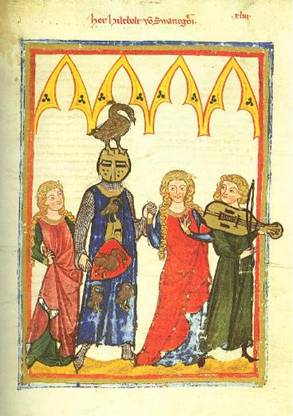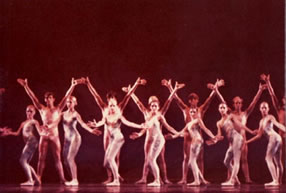Estampie (1981)
Ballet for Small Orchestra
Duration: 18 minutes
2(pic)2(ca)2(asx)2/2220/4perc/hp.pf/str
Published Score available for sale
Versions for Clarinet, Cello,
Piano and Percussion and Piano Solo available
(see Chamber Music)
Movements from this work for Violin, Horn and Piano available
under the title Medieval Suite (see Chamber
Music)
Commissioned by The Dallas Ballet
Premiere Performance: October, 1981; Dallas Ballet Orchestra;
James Rives Jones, Conductor
Choreography by Gustavo Mollajoli
Estampie is a set of lively variations on a Medieval tune. The eight short movements (Istanpitta Ghaetta, The Reversible Rag, Intermezzo, Scherzo, The Slow Sleazy Rag, The Couple Action Rag, Rimbombo and The Reversible Rag Reversed) may be played separately or in groups.

Reviews:
…glows with a physical animation and delicate balance of moods that combine seductively with his all-encompassing sense of humor…a delightful interplay of rollicking rhythms and dissonant fragmentation that drew upon a Medieval refrain, ragtime colorings and a chilly serial melancholy. Strains of Scott Joplin were filtered through the jazzy Berlin sleaze of Kurt Weill or the eccentric whimsy of Erik Satie to create a poetic drama that teetered over the brink into a frenzied jamboree.
Colin Gardner,
The Los Angeles Times
…came into the world alive and screaming… The piece takes a medieval melody, an estampie, and rings rowdy and hilarious changes on it – it becomes a slow sleazy rag (lots of saxophone) that has somehow gone slumming in a Berlin cabaret in the 20’s, where there is a whiff of Viennese serialism in the air; by the end, all of this burst out into a simultaneous shivaree.
Richard Dyer, The Boston Globe


Estampie performed by the Dallas Ballet, October 1981
Program Note:
Rodríguez’ orchestral ballet Estampie was commissioned by the Dallas Ballet. It was completed in October, 1981 and premiered with choreography by Gustavo Mollajoli. The strong percussive element in the instrumentation is reinforced by the use of a Medieval estampie, which is quoted literally in most of the eight sections and is developed throughout the work:
I. Istanpitta Ghaetta. The estampie is announced.
II. In The Reversible Rag the Medieval rhythmdissolves into a four-note bass figure which expands into a twelve-note row, then shrinks back to the original four notes in mirror fashion. Over this accompaniment, a lopsided atonal rag appears (in two halves, each half containing its own mirror image) slightly out of phase with the bass. The first movement is then repeated.
III. In the Intermezzo (Adagio), the estampie is embellished with lyrical interludes while the ragtime mirror bass (this time in the treble) remains serenely in the background.
IV. In the Scherzo (the heart of the ballet) the regular rhythm of the estampie is sharply juxtaposed with disjunct atonal writing. Ragtime rhythms (with irregular accents in a regular context) are employed as a bridge between the two styles. As all the forces interact, the estampie appears to be swallowed up as contemporary rhythms and sonorities prevail. The Medieval element continues, however, disguised by the use of such Ars Nova techniques as the layering of countermelodies (discant) and the repetition of rhythmic units that function independently of the original melody (isorhythm). A synthesis of styles is thus reached, after which the estampie reappears in its original form.
V. The Slow Sleazy Rag, with a pompously Wagnerian beginning and ending, is based on the arpeggiated accompaniment of the first Adagio (III). This movement is a companion piece to the
VI. Couple Action Rag in that the two are slow/fast versions of the same material, as in traditional pavane/gaillard pairings. Here the cabaret, rather than the court, is strongly suggested.
VII. Rimbombo, or resonance, is a vigorous toccata with an angular discant again disguising the estampie. When the movement reaches its peak, the Medieval tune quietly emerges.
VIII. The finale, The Reversible Rag Reversed, is a grand quodlibet in which The Reversible Rag, The Couple Action Rag and the estampie are played simultaneously.